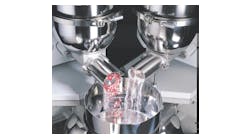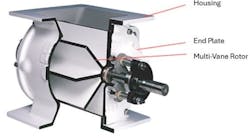The reception of dry raw materials in food processing is key to starting manufacturing on the right foot. Ingredients can come in many shapes and sizes, but many factories typically receive their ingredients in 50-pound bags, which can cause many challenges during the unloading, opening and disposal process plus require extensive amounts of labor. New powder handling solutions are available to not only help manufacturers automate this process, but also improve operator safety and well-being, food safety, hygiene and line capacity.
Challenges in powder handling
Even today, most producers in the food industry still have no choice but to receive their dry raw materials in 50-pound bags. Bulk delivery in trucks, railcars or super sacks is not available for all materials. Handling 50-pound bags means you need to rely on operators to depalletize, carry, open, tip and empty bags. But this is not as simple as it looks. With a tight labor market in the U.S. and Canada, it becomes a challenge to recruit and hire operators for manual jobs, and even more difficult to retain them.
Manufacturers in the food industry constantly look for solutions to improve the hygiene level on the production floor. One of the easiest ways to achieve that is to reduce contact between the operator and raw materials to avoid any source of contamination. Reducing raw material losses and increasing capacity to receive raw materials is top of mind for manufacturers as they look to improve their bottom line.
Automatic bag-opening machines are available on the market, but they don’t fulfill expectations, as this equipment can jeopardize food safety — with a risk of getting residue in the product — if the knives of the machine shred the paper or polyethylene layers of the bag. Equipment is usually difficult to clean, especially where there are chains, roller conveyors or drums where bags are tumbled. There is an increased risk of powder retention inside the machine when thorough cleaning is not done properly, potentially compromising food safety.
Another standard complaint during bag cutting is the emission of dust. When air filtration is not effective, a cloud of dust can form in the room, creating issues with operator safety and potential explosion hazards. In instances where the machine is fully enclosed to limit dust emissions, cleaning the machine becomes even more challenging.
Consider modular
A modular approach for powder handling solutions allows manufacturers to create a tailored approach for their operation. For those not ready or in need of a fully automated solution, a bag tipping unit such as the Tetra Pak SA VS800 can automatically tilt and cut the bags, which is a tremendous improvement from a fully manual operation, alleviating labor stress.
With even just one module equipped with a semi-automatic solution, operators do not have to carry bags to their tipping station or cut them manually with a knife. A set of six nonserrated blades helps ensure a clean cut of the bag’s paper layers to avoid any shredding and minimize powder retention in the bag. This semi-automated solution allows the job to become effortless and safe, and there is no more contact between the operator and the raw material.
For bag handling starting from a pallet, a depalletizing robot is an excellent solution. The robot can be equipped with a vision system to read the bag graphic and properly grab bags, even when the pattern of bags on each layer of the pallet is different. Tetra Pak also offers one step further in automation, starting from the raw material warehouse, with a system to manage the pallets according to the recipe. Pallets with different ingredients are brought by a forklift into the system. From there, pallets are automatically scanned and moved one after another to the robot, which picks up the exact number of bags needed for each ingredient according to the recipe. Once a pallet is empty, it leaves the system, and a new pallet is brought in. After that, a second robot can shake the empty cut bags as an operator would to minimize the material remaining in the bags before dumping them into a compactor.
Robots can help facilities transition to a more fully automated solution, so operators are not needed to handle bags. The only labor required remains the forklift driver to bring pallets of raw materials and a supervisor.
Safe and sanitary bag cutting
Solutions are also available to help alleviate the tedious task of cutting bag layers, from kraft layers to polyethylene. There is the standard need in the industry that allows up to four bag layers to be cut together, including both the kraft layers and the polyethylene layers.
Where hygiene requirements are high, such as in the infant formula industry, a kraft layer is not allowed to enter a high-hygiene tipping room. In these situations, kraft paper removal is typically done by hand. This job is very labor intensive, physically demanding and repetitive, not to mention the risk of injuries.
Tetra Pak has developed a solution to automatically remove this kraft layer without piercing the inner bag, allowing the dust on the outer later to be removed and the waste disposed, even for high capacities. This automated solution can effectively remove two to three layers of kraft paper. When the bags with one polyethylene layer enter the tipping room, such as a high-hygiene room, they are tilted and cut automatically. In addition, the empty layer is vacuumed through a pipe to a bag compactor located in the low-hygiene room where the kraft layers were removed to ensure maximum hygiene.
Automated systems can handle an array of bag sizes, but there will always be some limitations. If a bag is too large, too long or too light, the automated system may be unable to handle it automatically, but there is always the possibility to retrofit and use the machine to manually cut and tip the noncompliant bag easily and instantly. Furthermore, if an operator needs to get to the tipping station to manually cut a nonstandard bag, a light curtain covers the front of the cell to ensure safety. There is no need for a physical fencing around the robot, so you can go back to a manual operation if needed with no downtime.
For some applications requiring a very high level of hygiene, UV tunnels can be used to decontaminate the outer layer of the bags before opening them. To ensure maximum hygiene, an automated cleaning system with air can remove dust on the outer layer and on the top and sides of the bag.
A best-in-class approach
Manufacturers have many options when selecting powder handling equipment, and using the best equipment for the application is key to success. A bespoke approach to handling bags of all shapes and sizes can cause challenges for operators, but those challenges can be turned into opportunities when managed correctly. Semi-automatic to fully autonomous solutions on the market can be customized to each facility’s needs to help reduce labor strain while improving hygiene and safety.
Jean-Christophe Margotteau ([email protected]) is manager for Powder Handling Solutions with Tetra Pak U.S. and Canada. He has over 18 years of experience in sales and business development for the food processing industry. His knowledge covers ergonomics and operator safety, product quality and safety, protection against the risk of explosion, and reduction of downtime of the lines. In his role, he helps automate customers’ powder handling processes.
Tetra Pak




